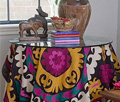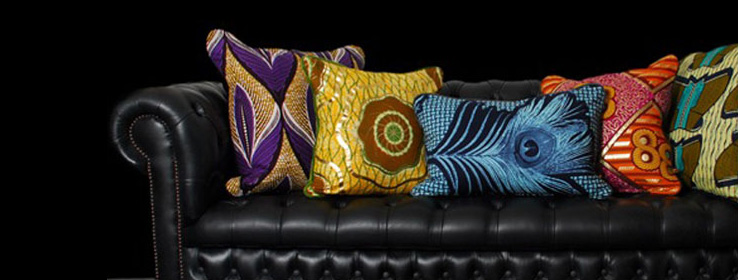With an aesthetic that embraces a cross-section of colors, cultures and styles, a Bohemian-inspired space can be as unique as the person it was designed for.
Bohemian interiors are free-spirited affairs that encourage the informal mixing and layering of colors, textures and furnishings. The "boho" motto is "less is never more." For highly conscious homeowners who are rejecting cookie-cutter sameness by shopping for one-of-a-kind items online at eBay and Etsy, as well as at specialty stores and flea markets, it's a fitting style.
Lately, I've noticed an increased global-ethnic influence that's bringing even more dramatic hues and patterns into the Bohemian design style. In fact, tribal textiles are especially haute items right now for those designers and homeowners willing to try something truly different and more colorful.
For centuries, cultures around the world have designed textiles for decorative purposes, to give as gifts and for recording their history. And while a few daring designers have been ahead of the curve over the last few years – incorporating African, Asian and Latin American textiles into interiors – those who haven't can hardly escape noticing the presence and influence of global-ethnic textiles in design, thanks to globalization and increased access to other cultures.
Cristi Ambroson, owner of Tessera – a Houston-based business that sells global-ethnic home furnishings – travels to Central Asia and Peru a few times each year to handpick items for her store. She often finds vintage pieces at open markets and even in the attics of residential homes (with the residents' permission, of course!). Ambroson says that Suzani items – colorful, hand-embroidered textiles from Uzbekistan – are among her most popular products. Suzani-inspired motifs are a hot design trend right now – appearing on everything from pillows and area rugs to towels and dinnerware – but this art form's cultural significance shouldn't be overlooked.
Traditionally, Uzbek women began embroidering a Suzani at the birth of a daughter and would later teach the craft to the girl. Together, they would continue stitching the Suzani with the help of family and friends, until the daughter married. The new couple then received the Suzani as a gift to use as a bed covering. Vivid hues including orange, purple, pink, yellow and red (the color of fertility) are used to create these textiles. The natural dye materials for the colors include madder, cochineal, indigo, walnut, pomegranate and sumak, along with assorted others.

While it's clear that the Uzbek culture highly values and is very comfortable with color, that's not always the case with customers at Tessera. "People will ask if I have anything more neutral or less colorful," Ambroson laments. To ease her customers' color fears, she recommends they start with pillows or a smaller Suzani that can be draped over a sofa or bed. Very small pieces can even be framed and used as artwork.
This approach is, in my opinion, a great introductory way to design a Bohemian space. It's less intimidating when you have one inspirational piece to build on and pull colors from. Because boho hues are usually a mix of saturated colors and earth tones, it's often easiest to use neutral colors for the walls. Then you can layer on colorful textiles – using them as tablecloths, curtains and even upholstery. In addition to Suzanis, fabrics from Africa make stylish and colorful accents in Bohemian decor.
"I am always inspired by the vibrancy and richness of African fabrics," says Eva Sonaike, who owns a London-based business that bears her name. Sonaike is Nigerian and was raised in Germany. Her collection of luxury pillows, fabric-covered notebooks and bags is a result of her exposure to Western and African culture.
"Many people still associate famine, war and suffering with African countries; but I, and many others, know a different side. Style, color and fabrics are very important to us, and many Africans incorporate these elements into the design of their homes."
Sonaike's fabrics combine the vibrancy of African colors and the elegance and understatement of Western design. African textiles incorporate many different hues that vary by country. For example, according to Sonaike, the color blue is very important in Nigeria's Yoruba culture. "This goes back to the days of indigo dye. Blue also represents the presence of God," she explains.
Sonaike says that there are no rules or limits when using African-inspired fabrics. "You can combine any colors and they still look chic and sophisticated." I love her idea of using cushions as ornamental pieces by scattering them on the floor; plus, they're great for extra seating, which is a very Bohemian thing to do.
Coincidentally – or perhaps not – a Bohemian-inspired design syncs nicely with the new Restless Nomad palette from Sherwin-Williams® Colormix™ two-thousand-eleven. This sultry and exotic palette is characterized by colors that wander all over the globe – from dusky darks to elemental earth tones to hot vibrant pinks and reds – and includes influences from Morocco, Turkey, Indonesia and Iran.
I'm excited to see how global-ethnic fabrics and furnishings are affecting modern design. Thanks to the Internet and passionate entrepreneurs, cultural pieces are available to us no matter where we live. So whether a Bohemian look is what you're after or you just want a unique statement piece, the world is truly your design oyster.





